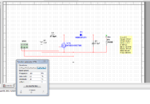Eshal
Advanced Member level 1
- Joined
- Aug 29, 2012
- Messages
- 470
- Helped
- 16
- Reputation
- 32
- Reaction score
- 15
- Trophy points
- 1,298
- Location
- Nowhere :)
- Activity points
- 5,149
Heyyy... new thing for me. wait a second. let me understand this point.
If I reduce the voltage amplitude to the MOSFET then I can lose the efficiency. And also, the MOSFET will not work as a switch anymore, it will work as resistance instead. Is it?
And if I want to retain the efficiency of the Boost Converter then I should reduce duty cycle not voltage amplitude. Did I understand right?
Thank you very very much. so helpful posts.
- - - Updated - - -
I have reduce the duty cycle.
Here is my simulation then. I just reduce the duty cycle to 53% from 76% and removed the series limiting resistor of 0.4ohm.

I have gotten what I want. I am getting Vout=5.2v and Iout=500mA.
Now I want to know is there any precaution which I should remember like MOSFET heating or something like that?
Also, I want to know why reducing duty cycle didn't affect too much at the output voltages. But it affect the output current. I have heard from someone that the increasing duty cycle will increase the on time of the MOSFET and the long the MOSFET will conduct (means on time) the more the efficiency. Is it not true at all. huh?
If I reduce the voltage amplitude to the MOSFET then I can lose the efficiency. And also, the MOSFET will not work as a switch anymore, it will work as resistance instead. Is it?
And if I want to retain the efficiency of the Boost Converter then I should reduce duty cycle not voltage amplitude. Did I understand right?
Thank you very very much. so helpful posts.
- - - Updated - - -
I have reduce the duty cycle.
Here is my simulation then. I just reduce the duty cycle to 53% from 76% and removed the series limiting resistor of 0.4ohm.

I have gotten what I want. I am getting Vout=5.2v and Iout=500mA.
Now I want to know is there any precaution which I should remember like MOSFET heating or something like that?
Also, I want to know why reducing duty cycle didn't affect too much at the output voltages. But it affect the output current. I have heard from someone that the increasing duty cycle will increase the on time of the MOSFET and the long the MOSFET will conduct (means on time) the more the efficiency. Is it not true at all. huh?

